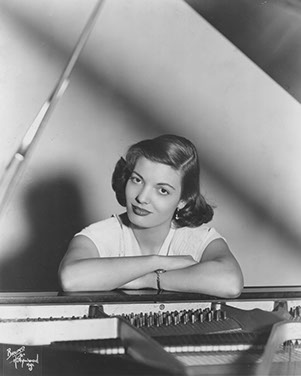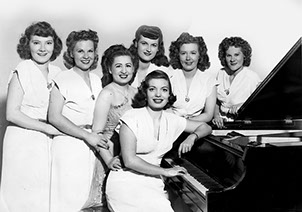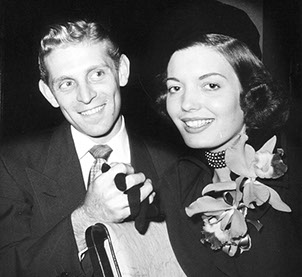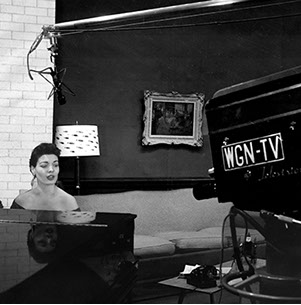


One of Audrey's earliest solo publicity photos and was taken by Bruno of Hollywood. As an aside, the photographer has a significant background. A Google search will provide some interesting history. He was one of the first to photograph Marylyn Monroe and other famous stars of the era.

In the late 1940s, Audrey joined an all-girl band, and the arranger, Gene Gifford, insisted she sing as well as play. She obliged nervously with "What More Can a Woman Do", one of Peggy Lee’s first efforts as a lyricist. "I must have been awful", Audrey says. "But once I tried it I knew that this was what I wanted to do".

Audrey and her husband, Stu Genovese, were married in 1949 and were together for 54 years until his passing in 2003. Stu was very active as a musician himself, playing wind instruments throughout his life in many bands and orchestras, both locally and on the national circuit. He was also a well-loved Band Director at Chicago's Carl Schurz High School for many years.

Throughout the 1950s, Audrey made many guest appearances on local Chicago TV and quite regularly on various radio stations.
In the 1950's, one of the charms of a Chicago night was the sleek brunette who sang and played piano at Mister Kelly’s, a famous stop on the supper club circuit. Seated at a spinet between two staircases, Audrey Morris defied the mealtime chaos with her quiet portrait of a world-weary romantic. "Do they know, do they care … that I’m lonely and low as can be / And the smile on my face isn’t really a smile at all?" she sang, in a sweet, wry voice that refused to take a broken heart too seriously. Her sets were full of classy tunes no one else seemed to know, and after midnight she was surrounded by jazz greats -Billy Strayhorn, Teddy Wilson, Chris Connor, Sylvia Syms- who had drifted in from other clubs to listen.
That golden era of jazz-cabaret lasted only a few more years, but Audrey and her songs have proven timeless. Since Mister Kelly’s, there has scarcely been a time when Audrey wasn’t enhancing Chicago’s nightlife with her honest, poignant interpretations of classic pop. George Shearing calls her "a lady with exquisite taste", and never was this truer than on "Round About", a late-night set of ballads by some of the masters Audrey discovered as a teenager: Johnny Burke, Irving Berlin, Leo Robin, Vernon Duke, and others. She delivers their songs with a dry-eyed self-knowledge, a dash of humor, and no frills, in a voice that sounds warmer and plusher than ever. Joining Audrey here in her sixth album are two of the most elegant players in Chicago: Joe Vito, her pianist on all but one track, and John Frigo, with his lyrical jazz violin.
Like Joe and John, Audrey grew up on the South Side of Chicago, which is where her relationship with songs began. Studying classical piano as a child, she was distracted by the family radio, which played all the latest tunes from the Hit Parade. To the pre-adolescent Audrey, those songs evoked "things that were pretty, sometimes things that were sad", and she sat in grade school writing the lyrics in her notebook while pretending to work on her lessons. She started spending her seventy-five-cent allowance on sheet music, while studying the voices she heard on radio and 78s. Her favorites were Billie Holiday, Lee Wiley, Mildred Bailey, and Peggy Lee, who "sang a song as if they were speaking it, without a lot of volume. It seemed more expressive that way". Then she discovered Nat King Cole, who sang just as intimately while playing piano at the same time.
Audrey didn’t attempt this herself until the late 40's, after she had worked as a pianist in a high school band and at a Chicago yacht club. Subsequently she joined an all-girl band, and the arranger, Gene Gifford, insisted she sing as well as play. She obliged nervously with "What More Can a Woman Do", one of Peggy Lee’s first efforts as a lyricist. "I must have been awful", Audrey says. "But once I tried it I knew that this was what I wanted to do".
In 1950 she began singing and playing at the Capitol Lounge on State Street. To her dismay, Audrey found that women in her new profession were generally hired to look sexy and to keep the booze flowing with raucous sing-along tunes like "Ace in the Hole" and "Heart of My Heart". She refused to comply: "I just didn’t think I did the barroom songs well, so I sang ballads instead. I used to get fired a lot".
Soon, though, she met a few female singer-pianists in Chicago who shared her integrity. The somber minimalist Jeri Southern had taken residence at the High Note, while Carmen Kirby (later Carmen McRae) was building a following at the Copa Lounge. "If you had decided you weren’t going to sing the bawdy songs that people expected", says Audrey, "and you walked in and saw Carmen sitting at the piano, looking and sounding as beautiful as she did, you thought, maybe this isn’t impossible".
In 1954 Audrey moved into the newly-opened Mister Kelly’s, starting work each night at dinner hour. "Sometimes you could barely hear yourself, it was so noisy", she says. "But around eleven o’clock it would mellow out, people were willing to listen, and those were the beautiful hours". She quickly became a magnet for other performers, from the fine local singers –Lucy Reed, Bev Kelly, Frank D’Rone, Lurlean Hunter, Johnny Janis, Pat Morrissey– to visiting jazz royalty. "I got to meet all my idols", she says. Billie Holiday came to hear her at the Churchill club, and ended up singing "Fine and Mellow" to Audrey’s accompaniment. At the Streamliner, she looked up to find Duke Ellington grinning at her and saying: "You sure make my songs sound pretty!"
She made her first album on the tiny "X" label, a division of RCA, in 1955 "Bistro Ballads", a program of recherché tunes like "Come in Out of the Rain" (a King Cole Trio rarity) and Murray Grand’s "Guess Who I Saw Today". The next year, Bethlehem Records signed her to record "The Voice of Audrey Morris" with arranger Marty Paich. "I was allowed to choose all the songs", she says, "and I knew that if I did that, the albums would go nowhere". Yet Down Beat praised her "faultless diction, sensitive voice, and choice way with a lyric", and Warner Brothers even offered her an exclusive contract to record movie theme songs and perhaps appear onscreen. But rather than surrender her freedom to play and sing anywhere she chose, Audrey turned them down. Instead she began a five-year stint as leader of the intermission trio at Chicago’s London House, a jazz piano club. There she shared bills with virtually every great pianist in jazz, notably George Shearing and Oscar Peterson, both of whom became her lifelong friends and fans.
By the time London House closed in the early 60's, rock and roll had taken over the airwaves she had once cherished. "You started to get requests for things you didn’t care to do, and I didn’t learn any of them", Audrey says. "You could see the change coming, but what could you do about it?" As the decade ended she reduced her work schedule to a night or two a week in order to raise her newborn son. Not until 1981 did she accept another full-time booking, at Chicago’s Palmer House. Larry Kart of the Chicago Tribune called that "return" engagement "an absolutely magical musical experience" adding: "Audrey Morris creates an aura of intimacy that can quickly engulf the listener".
She does so again on "Round About", with the help of two old and dear friends. Joe Vito is known for leading his own groups, but as an accompanist, says Audrey, "he knows exactly what’s in your head, and he plays what’s in your heart". So does John Frigo, who started his career as a bassist with Jimmy Dorsey and a comic fiddle player with Chico Marx. "John writes lyrics himself, he knows lyrics, and he’s singing them in his head as he plays", she notes.




